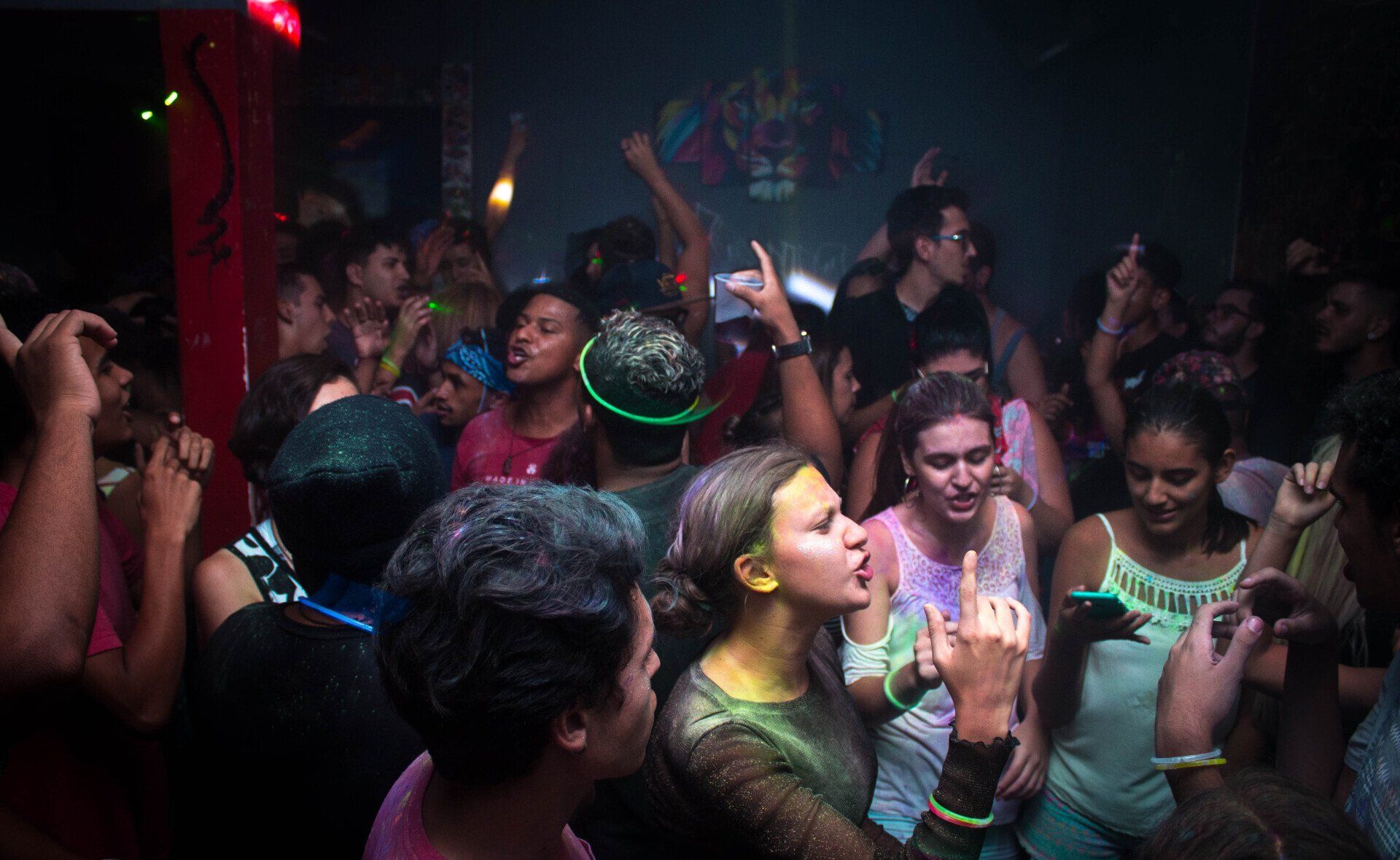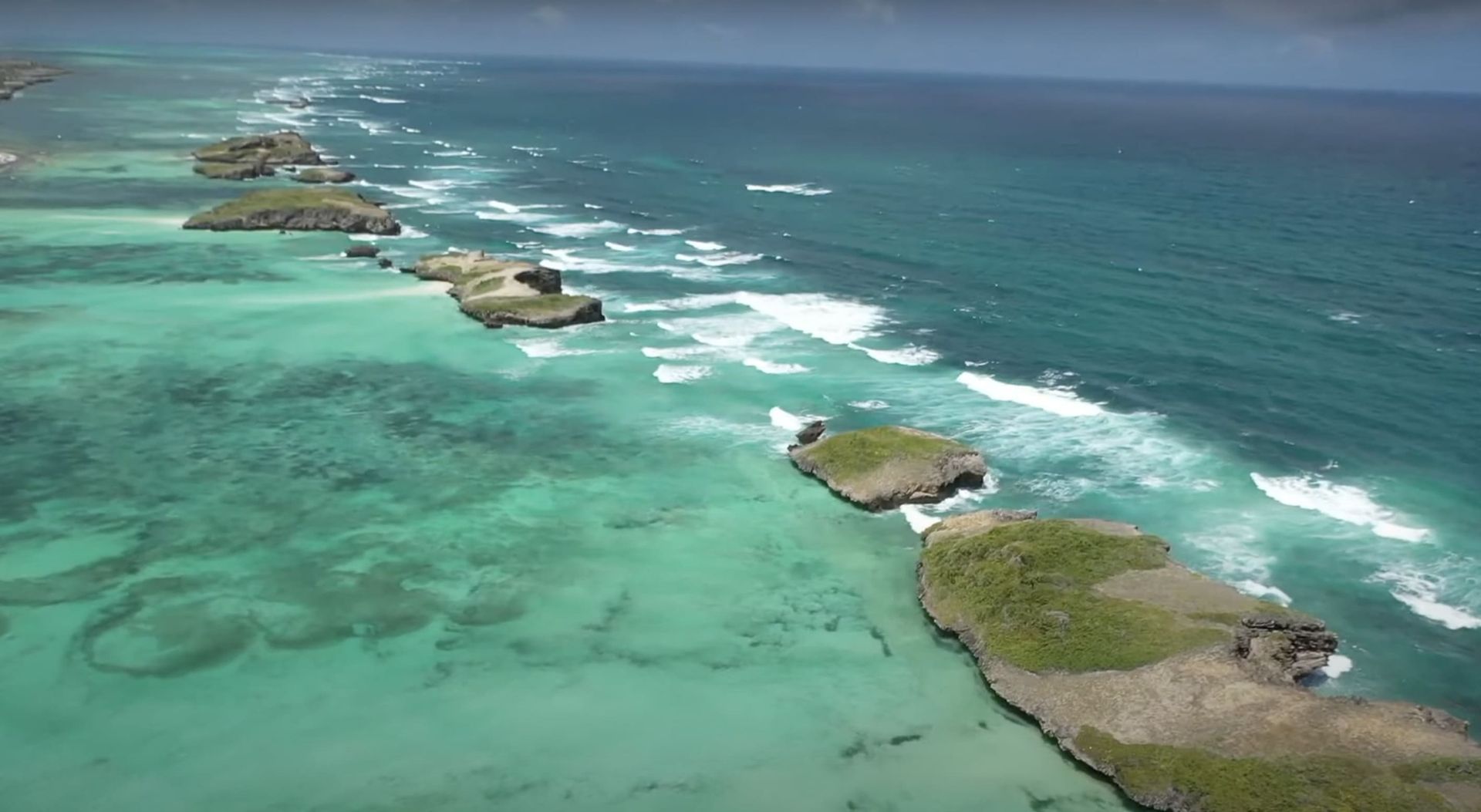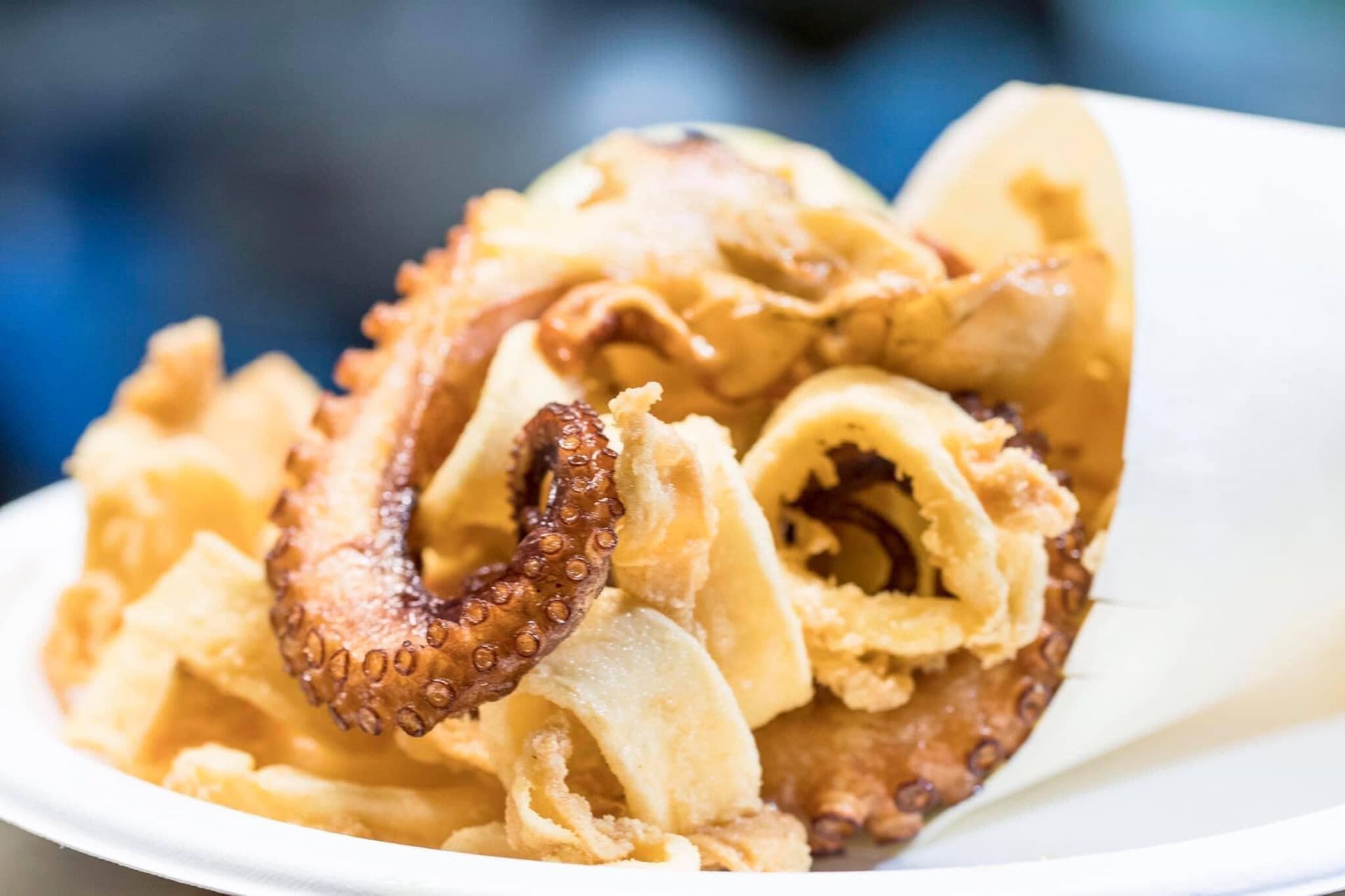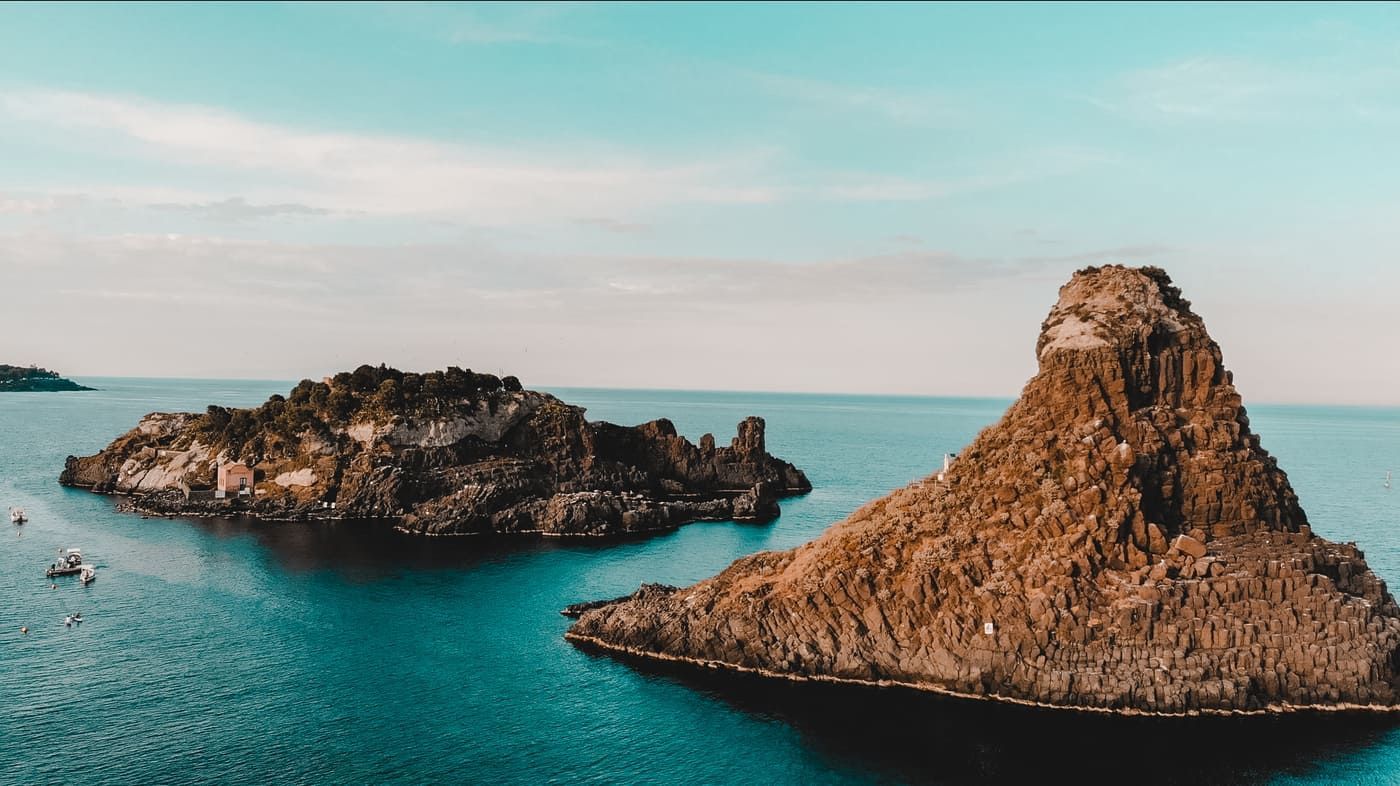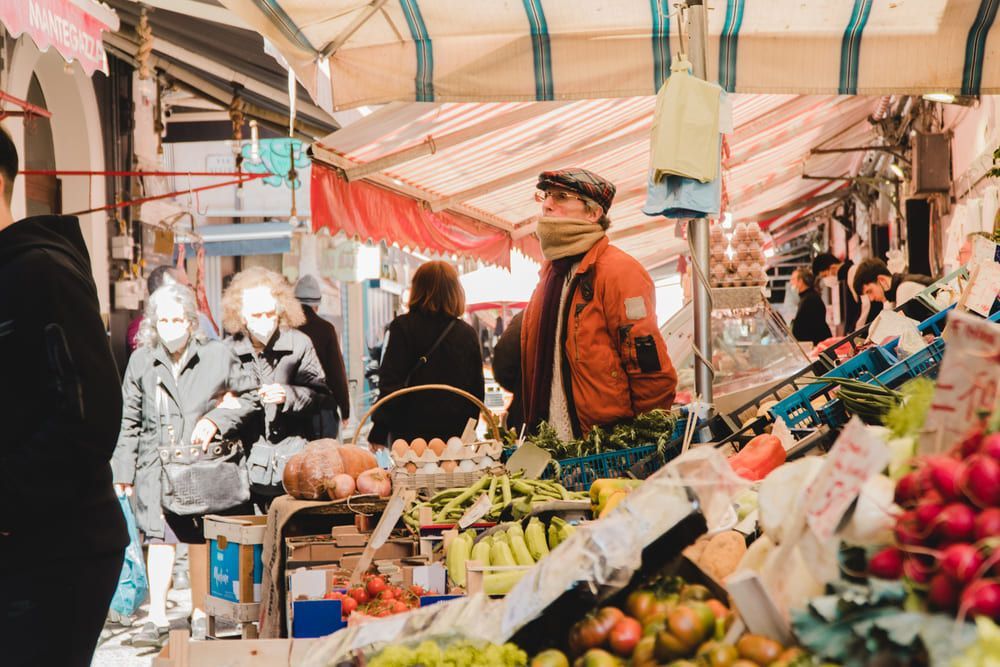18 Must Read Facts about Catania by a local
🦞 What is Catania best known for? Here's 18 facts you'd only know if you were a local...
You are wandering through Catania and you feel the magical vibe, the spirit of a city that has defeated history, and flourished on the slopes on an active volcano.
This seemingly precarious coexistence with Mount Etna has profoundly influenced the very essence of its people.
They embody a fiery spirit, radiating joy and a vibrant sense of humor that effortlessly endears you to the city's soul.
Moreover, Catania's deep-rooted connection with Etna has given birth to a rich tapestry of legends, stories, and traditions, each adding to the uniqueness of this remarkable place.
Today, we're excited to unveil some incredible facts, captivating tales, and enduring legends about Catania.
These insights are set to transform your understanding and appreciation of this extraordinary city, revealing the layers of history and culture that make it truly one-of-a-kind.
1. Etna's largest eruption was in 1669:
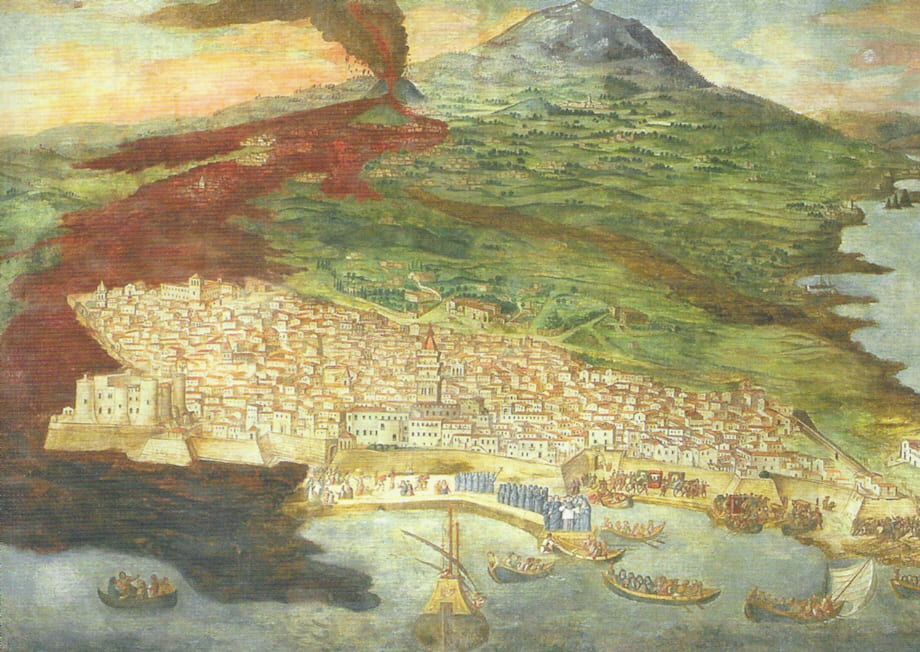
The 1669 eruption of Mount Etna was a catastrophic event. It completely submerged numerous towns along the slopes of Etna, and the relentless lava flow eventually reached the walls of Catania.
In a menacing advance, it encircled the Castello Ursino and approached from the south, almost breaching the city, near the location of the present-day fish market.
Luckily, the lava flow ceased just short of causing further devastation, bringing to a close a dramatic and perilous chapter in the history of Catania.
2. Piazza Università holds 4 "secrets"...
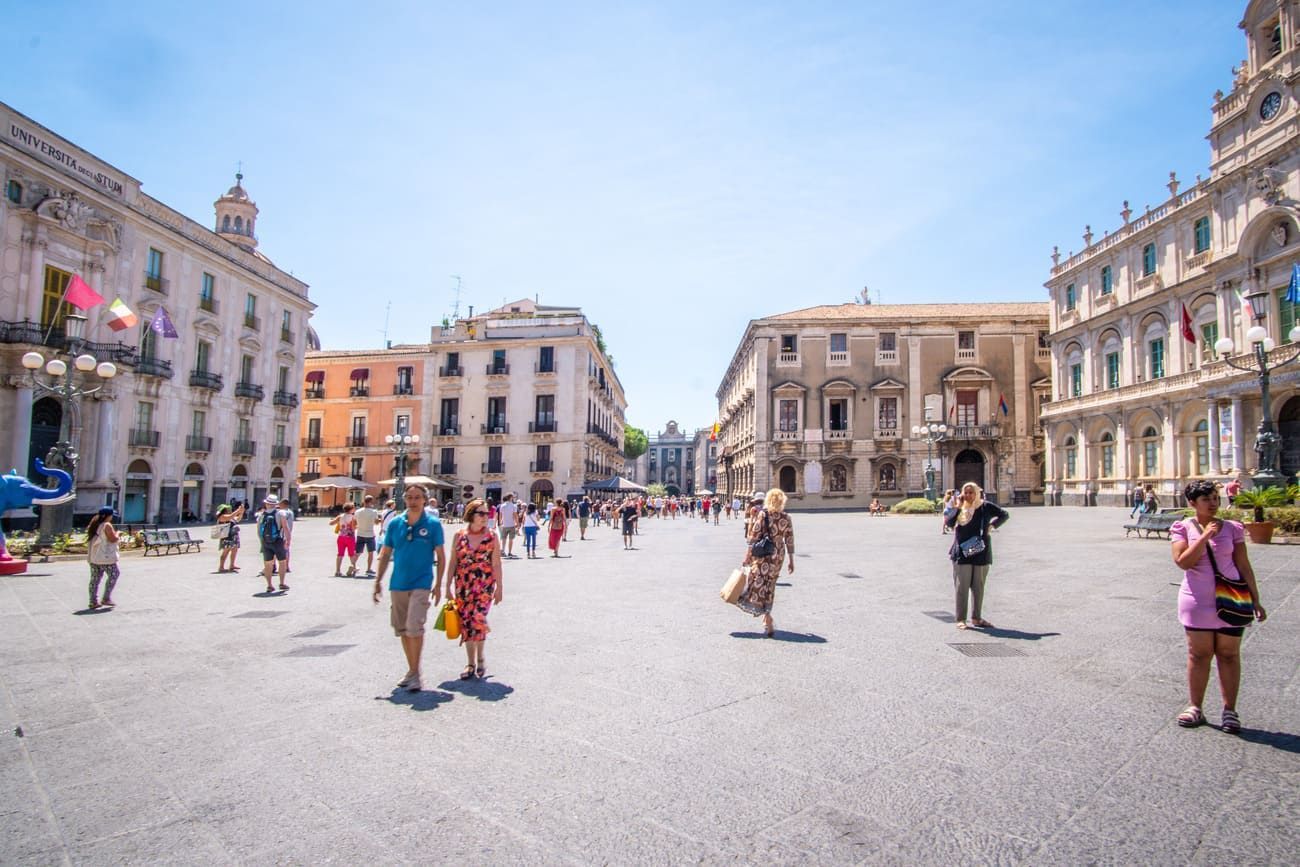
If you really pay attention, In Catania's Piazza Università, the 4 lampposts are crafted to tell the 4 stories that shaped the people and belief of Catania. Here the 4 stories.
- Gammazita, a beautiful woman from Catania, chooses death over dishonour, plunging into a well to escape a lustful French soldier. Her story, immortalised in bronze (you can see the sculpted body of a woman upside down in a well), is a testament to unwavering virtue, a whisper of courage echoing through the ages.
- Paladin Uzeda: Uzeda, born into poverty, rises through valor and defeats a Saracen in battle, winning the hand of a princess. His lamppost tells a tale of defying fate, proving that even beneath humble stones, greatness can lie dormant.
- Fratelli Pi: Two Catanian brothers, caught in a fiery eruption, are carrying their elderly parents on their shoulders. The lava, "moved" by the gesture, alters its flow to avoid submerging the family. Their tale, frozen in bronze, is a tribute to familial love, a reminder that even in the face of molten peril, blood runs thicker than lava.
- Colapesce: Young Colapesce, gifted with the ability to breathe underwater, captures the king's curiosity. After a challenge from the king, who asks him to prove that he can breathe underwater by diving really deep to retrieve an object, he reaches the pillars of the very earth, and seeing them breaking, he decides to sacrifice his life and hold the earth on his shoulder, saving everyone else.
3. Catania has 2 UNESCO Sites:
Catania is indeed blessed with not one, but two UNESCO World Heritage Sites:
- The Historic Centre of Catania: Piazza Duomo, the Roman amphitheatre, and the elephant fountain, earned its UNESCO designation in 2002. It's a testament to Catania's resilience, its rich Baroque architecture and vibrant cultural tapestry.
- Mount Etna:
Europe's tallest and most active volcano, Mount Etna, was inscribed on the World Heritage List in 2013. It's more than just a fiery behemoth; it's a natural laboratory, shaping the city's geology and providing fertile volcanic soil for its agriculture.
4. Catania has a special relationship with Etna:
At 3,329 meters, this volcanic titan is Europe's tallest active resident. It erupts a staggering 30-40 times a year! But have no fear, most of the eruptions are beautiful to look at and pose no threat! Here's a sprinkle of volcanic trivia to fuel your exploration:
- Catania's quality of food comes from mineral rich volcanic earth. The city's fertile slopes, nourished by volcanic ash, burst with citrus groves and vineyards. Besides juicy oranges, olives, grapes and lemons, Etna's unique mineral composition creates one of Sicily's best treasures: Bronte's Pistachios, with their rich flavour and deep green colour.
- Most buildings in Catania are built with lava rock: Did you know Catania's cobblestones are whispers of past eruptions? Stroll down Via dei Crociferi, and you're literally walking on 1669 lava.
5. Catania holds the second largest Roman amphitheatre in the world:
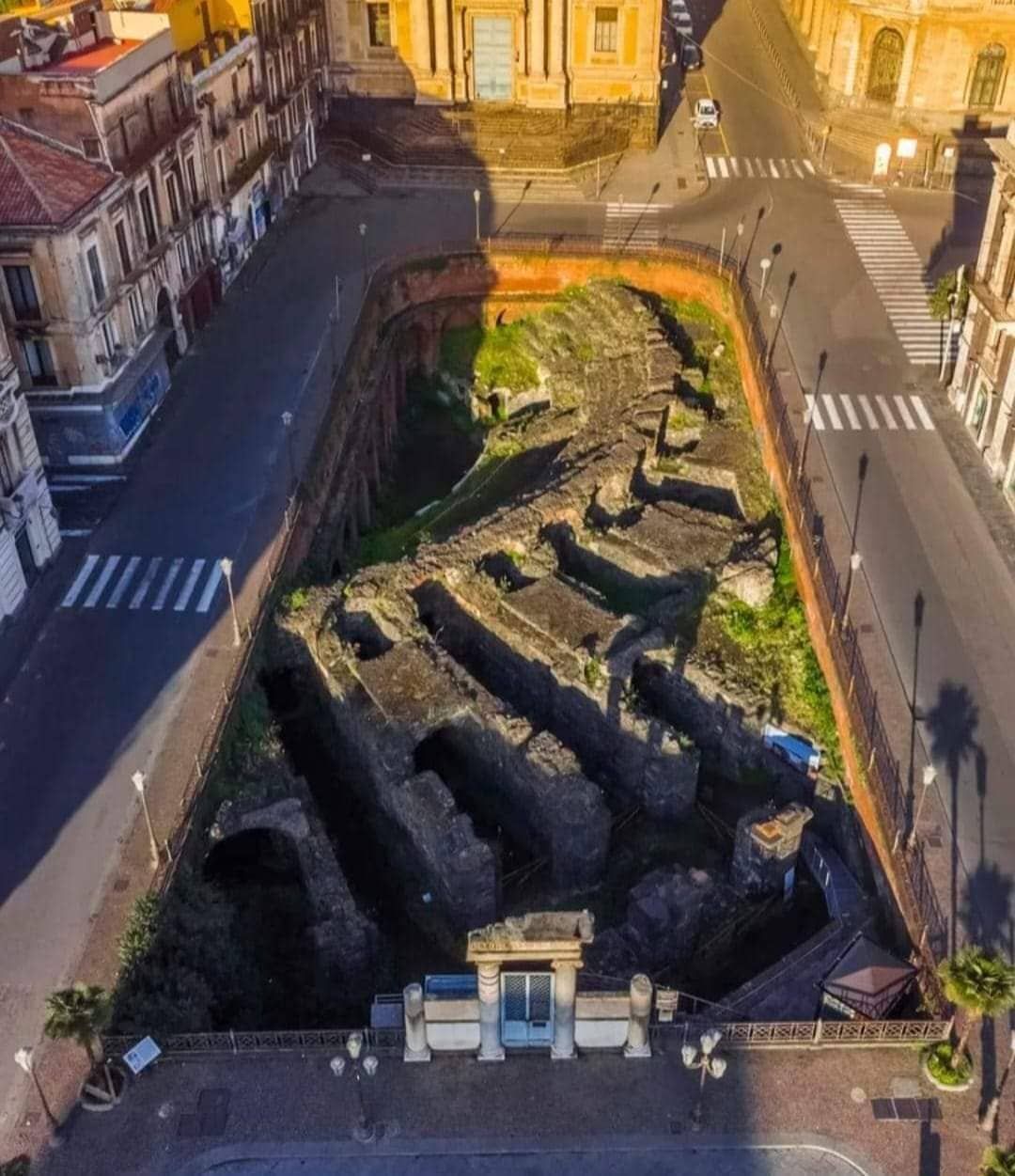
The Arena di Minerva, standing as the second-largest Roman amphitheatre in the world after the Colosseum, is now only partly visible.
Constructed with lava rock (hence named the "Black Colosseum") just a few decades after its Roman counterpart, it has a massive elliptical structure, stretching nearly 500 feet, rivalling any modern sports stadium in sheer grandeur.
But there's more. During Roman times, this very arena was transformed into a stage for grand naval battles! Ingeniously filled with water via an aqueduct, it hosted spectacular ship fights, a testament to Roman engineering and their love for grandiose spectacles.
Today, however, only fragments of this once-glorious theatre remain visible, mostly hidden beneath the urban landscape. It is located in Piazza Stesicoro. If you're intrigued to delve deeper, check out our dedicated article on the full story of the Roman Amphitheatre.
5. The celebrations for St Agatha attract around 1 million devotees
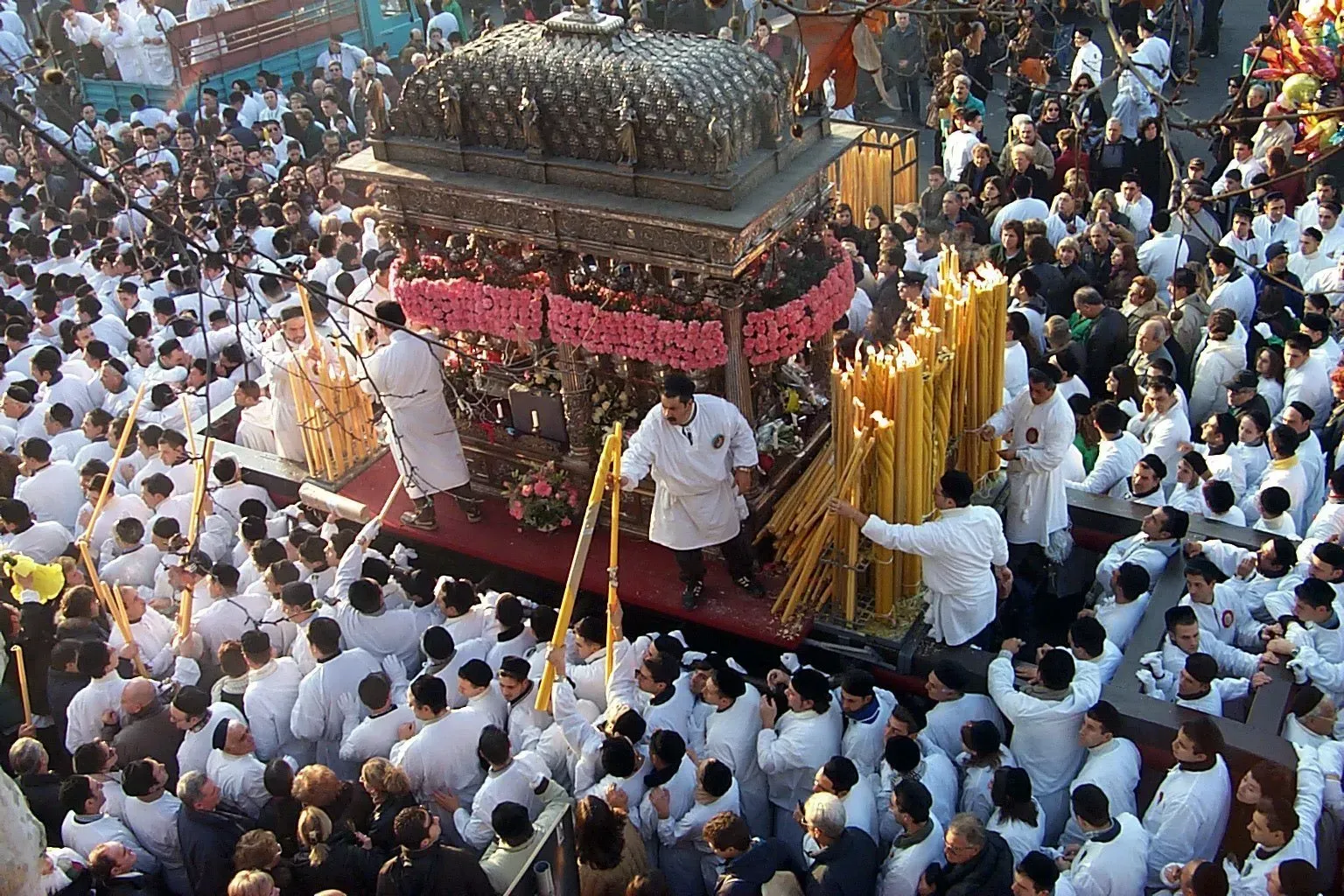
Catania's Festival of Sant'Agata is a fiery Sicilian spectacle, unparalleled in its fervor and grandeur.
From February 3rd to 5th, the city comes alive with over a million souls. Witness a 30-ton silver reliquary, heaved through ancient streets by thousands clad in white tunics. Yet, this is more than a mere parade; it's an explosive display of faith and history.
Fiery Saint: Agatha, Catania's revered patron saint, endured Roman torture for her unwavering faith, refusing to marry a Roman aristocrat. Legend has it that her breasts were cut off in her ordeal, but her spirit remained unbroken, leading to her martyrdom.
Lava Flow of Faith: The festival's highlight is the 3km-long "river of fire," where thousands of torchbearers light up the night, creating a mesmerizing path for Saint Agatha's reliquary.
Edible Homage: In celebration, Catanians indulge in "Minne di Sant'Agata," sugary confections adorned with cherries and ribbons, symbolizing the saint's resilience. These sweet treats are not just delicious but also a tribute to Saint Agatha's enduring spirit.
6. The legends of Catania's Elephant - "U Liotru"

Catania parades an unexpected mascot – the mighty elephant (locally known as "O Liotru")! It's a stone sentinel with an enigmatic past. Why an elephant, you ask? Here's where the mystery thickens:
- Some say the elephant guards Catania from Mount Etna's fiery outbursts, a protector born from the legend of a dwarfed elephant that roamed ancient Sicily.
- Others trace the elephant to Roman times, a symbol of Bacchus, the god of wine and good times.
- The Magician's Mount: A more whimsical legend whispers of Heliodorus, a Catanian magician obsessed with necromancy. His steed? You guessed it, a magical elephant!
Catania's elephant is a symbol as unique as the city itself. It's a reminder that history doesn't always come with dates and names, but with whispers, myths, and a sprinkle of the unexpected. You can admire the elephant monument crafted from lava stone in the square called "Piazza Duomo"!
7. The Fish Market is not just about fish!
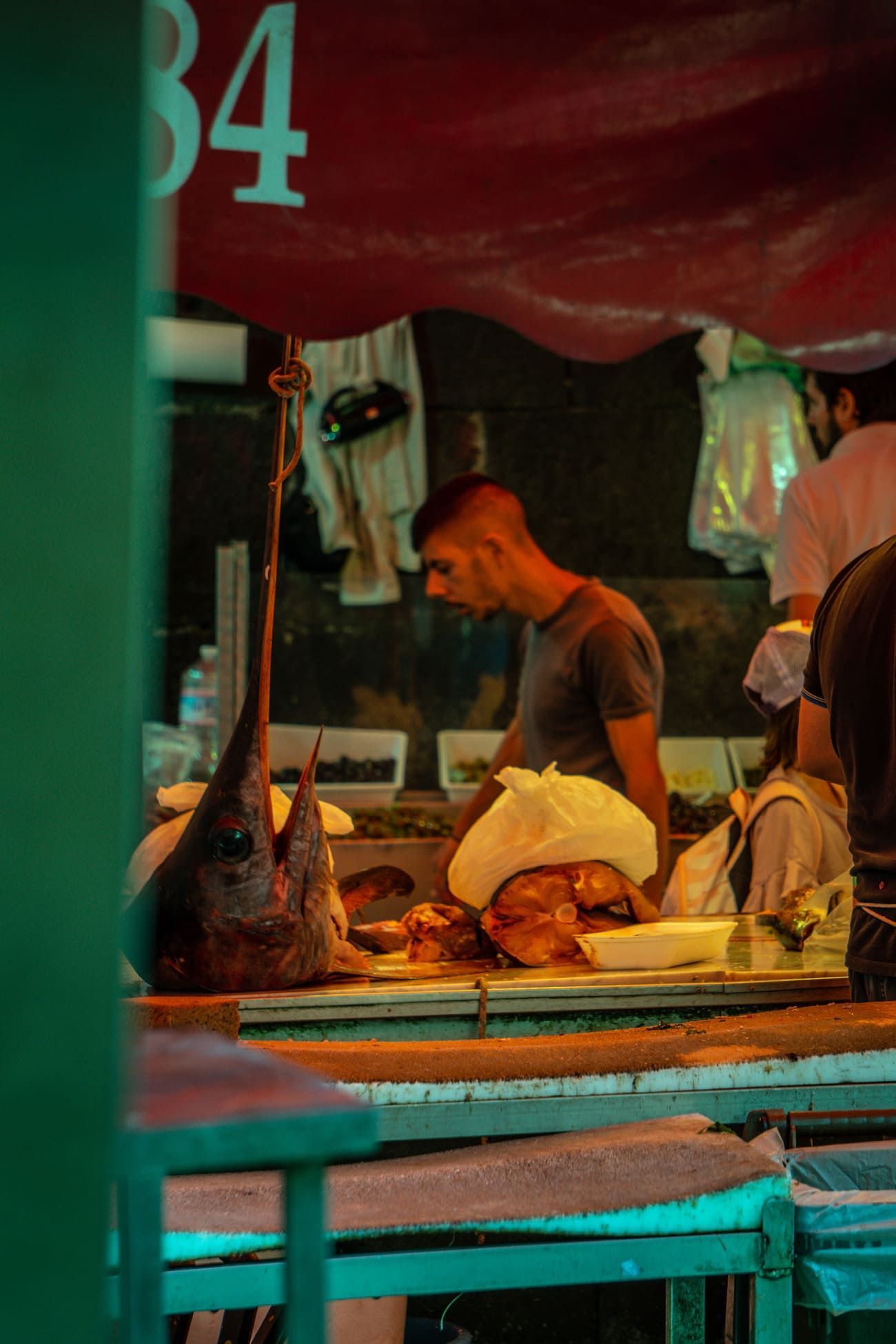
La Pescheria, Catania's legendary fish market, is a symphony of sights, sounds, and smells that assaults your senses in the best way possible. Towering pyramids of ruby-red prawns, glistening swordfish steaks whispering tales of the sea, and vendors with voices seasoned by salt air, weaving stories as they hawk their treasures.
But! La Pescheria isn't just about fish. Dive deeper and discover vibrant mountains of Sicilian vegetables, sun-drenched fruits of all kinds, pungent Arab spices, and an abundance of cured meats, cheeses and wines.
You can even sit down in one of the many street food places and enjoy a local selection of fish, cured meats, cheeses and wines.
Want to learn more about the legendary Fish Market and where to eat some good local street food? Read our in depth article about the Fish Market!
8. In the Fish Market you can see a part of the ancient bastion of Catania:
Embedded within the market's bustling chaos lies a fragment of the city's medieval bastion, a weathered whisper of its turbulent past.
It's a testament to Emperor Charles V, architect of Catania's 16th-century fortification. From these very stones, cannons were roaring, defending the city against pirates and Ottoman threats.
As centuries shifted, the sea claimed its due. The bastion crumbled, leaving this lone witness amidst the market's bounty.
So, next time you navigate La Pescheria's labyrinthine alleys, go see it. It is located in the tunnel that connects the
2 squares of the market.
9. In "Via dei Crociferi" runs the legend of a headless horseman...
Via dei Crociferi, a street renowned for its elegance in Catania, is shrouded in a spine-chilling legend – the tale of the headless horseman.
The eerie legend speaks of a headless horseman roaming via dei Crociferi. A young Catanian daredevil, fueled by bravado and wine, boasted he would walk Via dei Crociferi at night, defying the fear that gripped the city at dusk.
As the clock struck midnight, he set out on his reckless quest. Amidst the enveloping darkness, every sense on edge, he suddenly heard the ominous sound of galloping. A horseman approached. In a panic, his cloak snagged, and, convinced he was ensnared by the headless spectre, his heart succumbed to terror, sealing his tragic fate.
In truth, the tale of the headless horseman was a fabrication, a ruse concocted by the local nobility. They frequented Via dei Crociferi under the cover of night for their clandestine dealings, eager to keep prying eyes and gossiping townsfolk at bay.
Ironically, the young man was correct in his skepticism. Yet, it was fear, not the phantom, that claimed him. His untimely demise only served to reinforce the myth of the ghostly horseman among the citizens of Catania. A twist of fate, both tragic and ironic!
10. In 1693, a 7.4 Earthquake almost destroyed Catania
In 1693, Catania was struck by a devastating earthquake, one of the most catastrophic in Italian history. The quake, measuring a staggering 7.4 on the Richter scale, razed much of the city to the ground, reshaping its architecture and history.
This seismic event not only altered the city's landscape but also marked a significant turning point in Catania's urban development, leading to a remarkable phase of baroque reconstruction that defines its character to this day.
11. There are underground tunnels under the Cathedral of St. Agatha
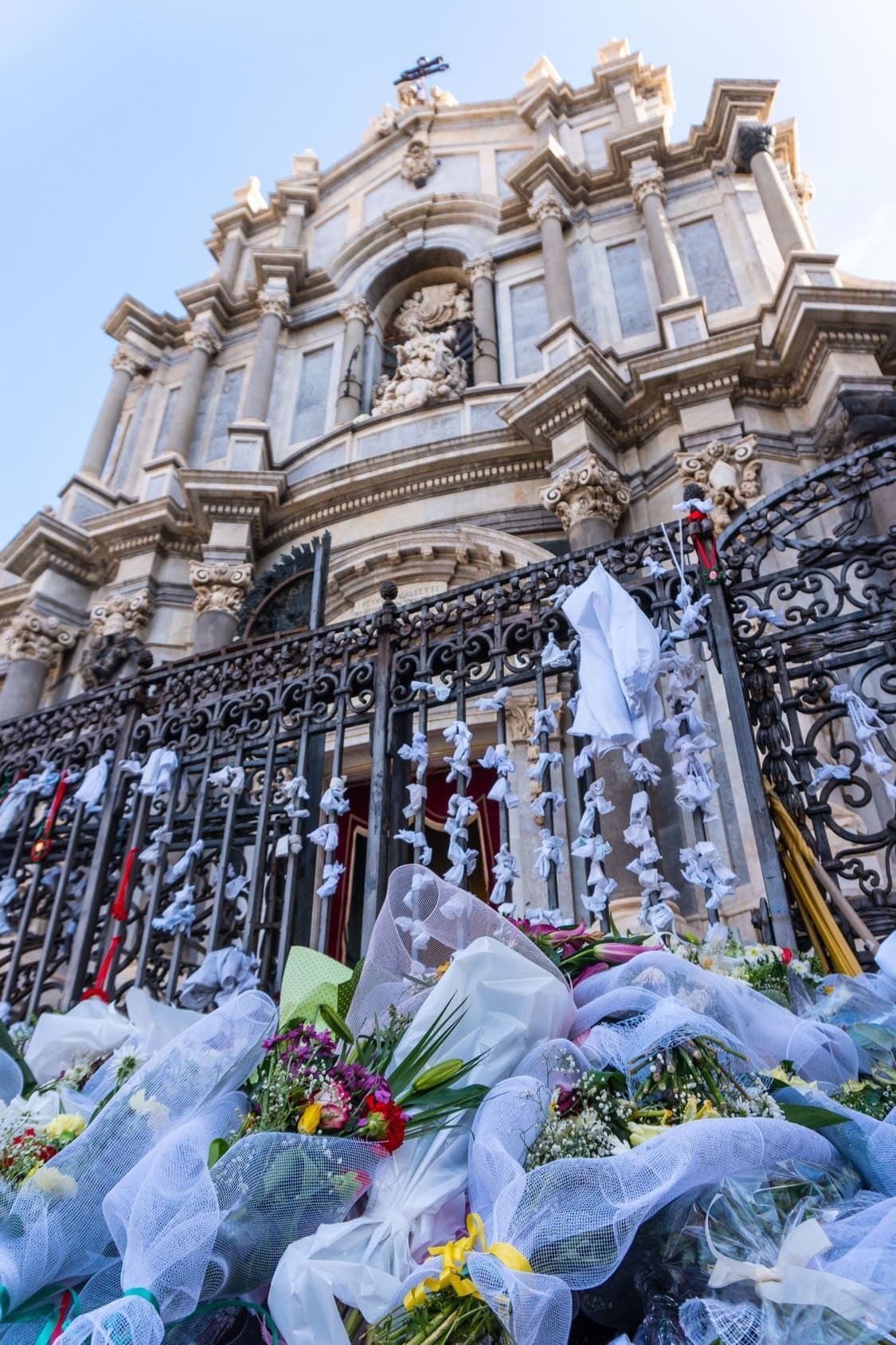
Hidden under the magnificent duomo, are the Terme Achilliane, ancient thermal baths dating back to Roman times. Often overlooked by visitors, mesmerized by the beauty of the square, these baths remain a hidden gem.
These Roman baths, forged from volcanic activity, used the earth's natural warmth to provide a place of relaxation and healing for the Romans. However, over time, they were buried by earthquakes and engulfed by the city's expansion, only to be rediscovered in the 18th century.
Today, these subterranean baths are accessible to visitors. You can wander through the barrel-vaulted corridors, feel the mosaic fragments that tell tales of a bygone era, and envision the Romans who once found comfort and health in these pools.
They are located directly underneath the majestic Cathedral of St. Agatha, in Piazza Duomo.
12. Catania's Teatro Bellini is the largest of Italians opera houses, after la scala di Milano:
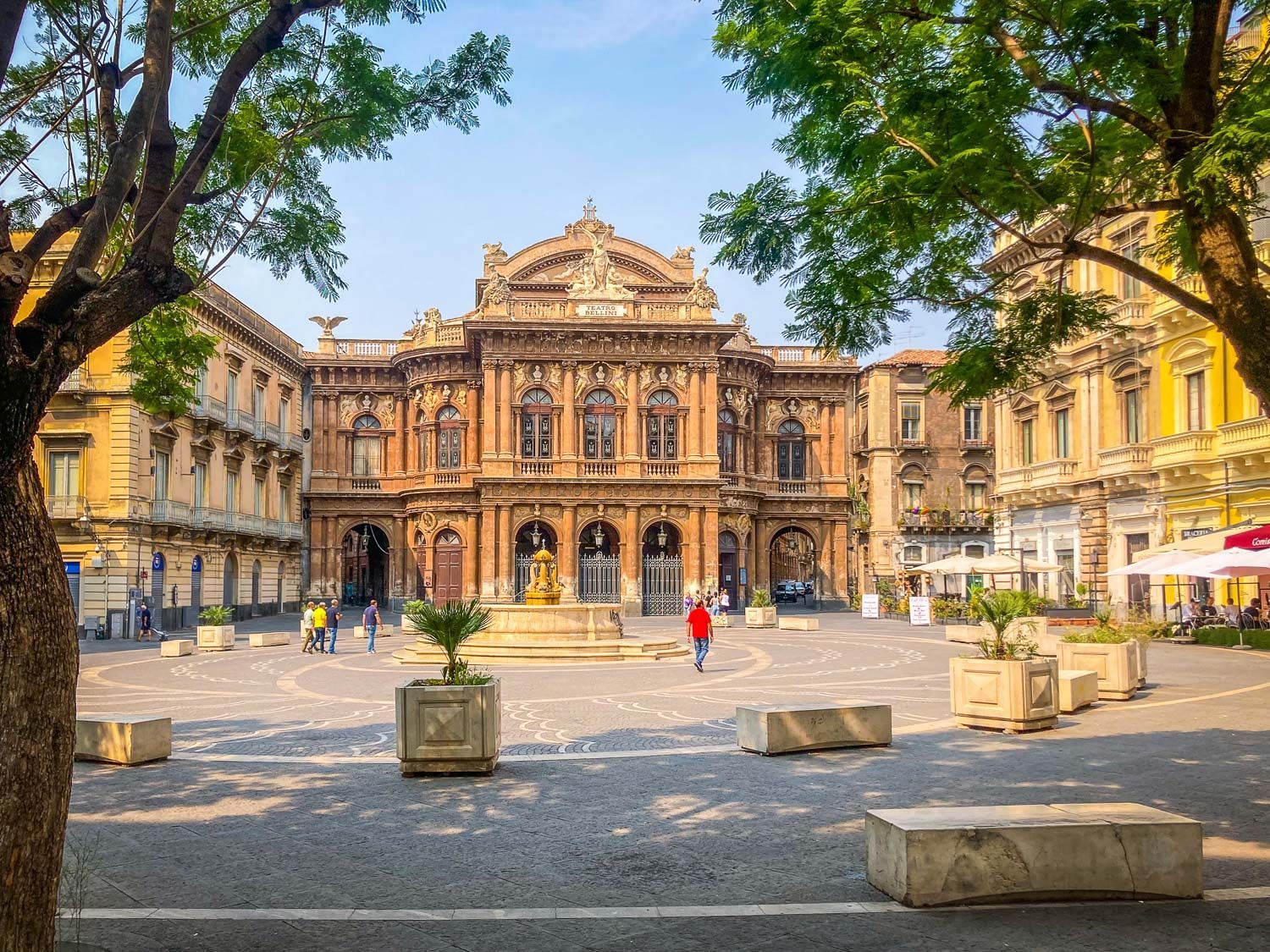
Catania's Teatro Bellini is a living, breathing embodiment of the city's vibrant soul. This magnificent theatre, the second-largest in Italy after La Scala in Milan, is a testament to Catania's passion for music and culture, a place where the art of opera is celebrated with passion and precision.
- Designed by renowned architect Carlo Sada, Its soaring acoustics have been praised by some of the world's greatest opera singers, including Maria Callas and Luciano Pavarotti.
- A History of Excellence: it was inaugurated in 1890 with a performance of Vincenzo Bellini's "Norma," the opera that the theatre is named after. Since then, it has hosted countless performances of opera, ballet, and other classical music.
- A Home for the Arts:
Teatro Bellini hosts a variety of events throughout the year, including concerts, festivals, and educational programs. It's a place where people of all ages and backgrounds can come together to experience the arts.
13. Granita, actually originated in Catania...
Granita, bursting with the essence of Sicilian sunshine and local flavors, isn't just a dessert; it's a refreshing heritage, a taste of summer woven into the city's very soul.
What's its history?
- Arab Whispers: Believe it or not, granita's roots trace back to the 9th century, when Arab conquerors brought their love for chilled treats to Sicily. These icy concoctions, infused with fruits and spices, were a luxurious escape from the summer heat, a whisper of Arabian indulgence on Sicilian shores.
- A Sicilian Twist: Over time, the resourceful Sicilians transformed this borrowed delicacy into their own. They ditched the cream base, embraced the island's bounty of fresh fruits and volcanic sweetness, and voila! Granita was born – a semi-frozen symphony of pure fruit pleasure, as light and fluffy as Sicilian clouds, with a playful crunch that dances on your tongue.
While granita gained widespread popularity, Catania remains its undisputed heartland. Here, the craft is honed to an art form, passed down through generations like precious family recipes. Each neighbourhood boasts its own signature flavours, from the classic lemon to the exotic mulberry, each spoonful a passport to Catania's unique terroir and vibrant spirit.
14. There is an underground river flowing in Catania
Catania holds a hidden jewel, an underground river beneath its bustling streets: the Amenano, a legendary underground river.
- The Amenano's roots delve deep into Greek mythology. The river god Amenanos, was a benevolent deity with the body of a bull and the face of a man. They believed the river flowed from his horns, nurturing Catania with its life-giving waters.
- The Amenano wasn't always hiding. Centuries ago, it danced under the Sicilian sun, feeding a shimmering lake within the city walls. But Mount Etna, Catania's fiery neighbor, had other plans. Successive eruptions buried the river's course, sending it into a watery labyrinth beneath the city.
You can admire it in unexpected places.
- Gaze into the Fontana dell'Amenano, a fountain located in Piazza Duomo, where the river peeks through.
- Go to "Putia dell'Ostello" (a restaurant and pub) and if you're lucky, you can visit their underground cave where you can see the river flowing in its original course.
15. Catania is the home of Street Food!

Catania's symphony of flavour unfolds on its very streets, a vibrant, messy, and utterly delicious opera of aromas, textures, and joyful chaos. Why is Catania's street food an experience your taste buds will never forget?
Unmatched variety: Arancini, bursting with creamy ragu or pistachio pesto, "sfinciuni", fluffy fried dough squares drenched in garlicky tomato sauce, and also cipolline, horse meat, granite, fried seafood, artichokes, and much more. There is way too much to tell, so we have dedicated a blog about "Best street food in Catania and where to find it".
16. Why is the city called Catania?
Where does the name Catania come from? What is the meaning of the word Catania?
Catania's name has 3 potential meanings, each rooted in different aspects of the city's history and geography:
1. Siculian Origins: The ancient indigenous population of the Sicels named their villages after geographical attributes of their location. The Siculian word "katane" is believed to have meant "grater, flaying knife, skinning place" or a "crude tool apt to pare." These interpretations could refer to the rugged terrain surrounding Catania and its volcanic soil.
2. Latin Connection: Around 263 BC, Catania was captured by the Romans and given various Latin names. One was "Catĭna," which was likely influenced by the Latin word "catinus," meaning "a gulf, a basin or a bay" or "a bowl, a vessel or a trough." This interpretation reflects the city's unique topography, situated near the Gulf of Catania.
3. Greek Origin: derives from the Greek prefix 'Katà,' meaning 'near' or 'leaning against,' combined with the name of the volcano, 'Aitnè' in Greek. The city, which sits at the slopes of the volcano, has been repeatedly devastated by earthquakes and lava eruptions.
17. The sea used to arrive all the way to the modern fish market
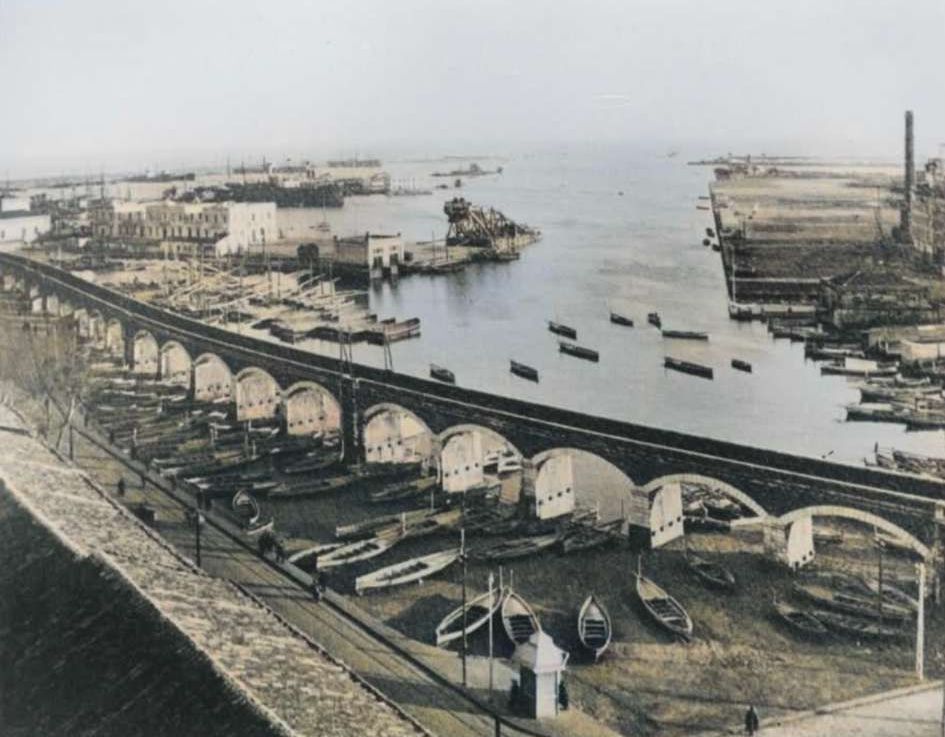
Until 1930, the sea lapped against the city walls near Porta Uzeda, where the train bridge is and the Fish Market is located. So the boats were actually unloading the fish right where the current fish market is located (see picture for reference).
Around the 1930s, the fascist regime decided to restructure the port, making significant modifications. This involved the filling and construction of quays, named Molo Crispi, to the east of the Archi della Marina, which were equipped for ship docking. The outer breakwater was extended by another 600 meters, creating the port that we see today.
18. Frequently asked questions
Is Catania Italy worth visiting?
Catania is definitely a must-see when it comes to Italy and Sicily. It offers a tapestry of experiences that blend history, nature, and gastronomy.
For the adventure seekers, the towering presence of Mount Etna, Europe's tallest active volcano, beckons with its unique hiking trails.
And after your ascent, unwind on the stunning volcanic beaches at Etna's base, full with scenic beauty.
Food enthusiasts will find themselves in a culinary paradise. Catania's vibrant street food scene is a celebration of local flavours, from the creamy, rich arancini to the pistachio desserts, seafood, and pasta delights. Every corner of this lively city offers a new and tantalising taste, making Catania a must-visit for those who revel in the joy of discovery.
Is Catania a walkable city?
Absolutely! Catania ranks as one of Italy's most walkable cities. Its bustling city center, centered around the pedestrian-only Via Etnea, allows you to explore the historical heart without the hassle of traffic. You're just steps away from the main historical attractions and stunning Baroque architecture.
Additionally, the city's culinary hotspots, from local restaurants to street food paradises and lively bars, are all conveniently accessible on foot. For a comprehensive guide on navigating Catania, be sure to check out our guide,
"Get Around Catania like a Pro".
Is Catania tourist friendly?
Locals are fiercely proud of their city, and their warmth is infectious. Ask directions, get serenaded by a fishmonger – embrace the unexpected! Catania isn't sterile – graffiti adorns buildings, streets can be chaotic, and scooters zoom like angry bees.
But this rawness is real, it's vibrant, it's Catania! "English? Parlo un po'". English isn't as ubiquitous as in Venice, but with hand gestures and some Italian basics, you'll crack the code.
Catania isn't a city for tourists who crave polished perfection. It's for adventurous souls who love authentic experiences, embrace chaos, and can laugh at a misplaced
Is it safe to walk Catania at night?
Strolling Catania at night can be a magical experience, but like any city, caution is key. The city center, with its well-lit piazzas and bustling streets, is generally safe for nighttime walks.
Observe how locals move around at night. Stick to areas where you see people enjoying the evening passeggiata, chatting animatedly in lively piazzas. While Catania is generally safe, solo female travellers might feel more comfortable sticking to main streets and avoiding dimly lit alleys. Remember, trust your gut and err on the side of caution.
Which areas to avoid in Catania?
Areas like San Cristoforo, Librino, and Stesicoro may not be as well-lit and lively at night. If you must pass through, consider using public transportation or taxis, especially alone.
While adventurous exploration is tempting, venturing far from tourist areas without local guidance, especially late at night, is not recommended. Remember, safety first
Find more local knowledge...
🗺️ Move like a local with our Customised Map of Catania...
Use the Google Custom MAP below to move like a local.
In the map we have saved all the best spots in Catania, so you can find them easily!
But, how does it work?
Simple! Just click on it (or this link) and the Map will open.
Click on
'VIEW MAP LEGEND', and you'll find collections with:
-Best Street Food in Catania
-Arancini Tour
-Best Fine-Dining Restaurants
-Food: Delicious yet Affordable
-International Flavours
-Best Bars to make New Friends
-Best Cocktail Bars
-Best Gelato
Enjoy!
👇
Click on the Map Below
🔎 Search the Blog...

Explore the city's best free activities, restaurants, and insider tips, all curated from our local and personal experience.
Great fun guaranteed.


